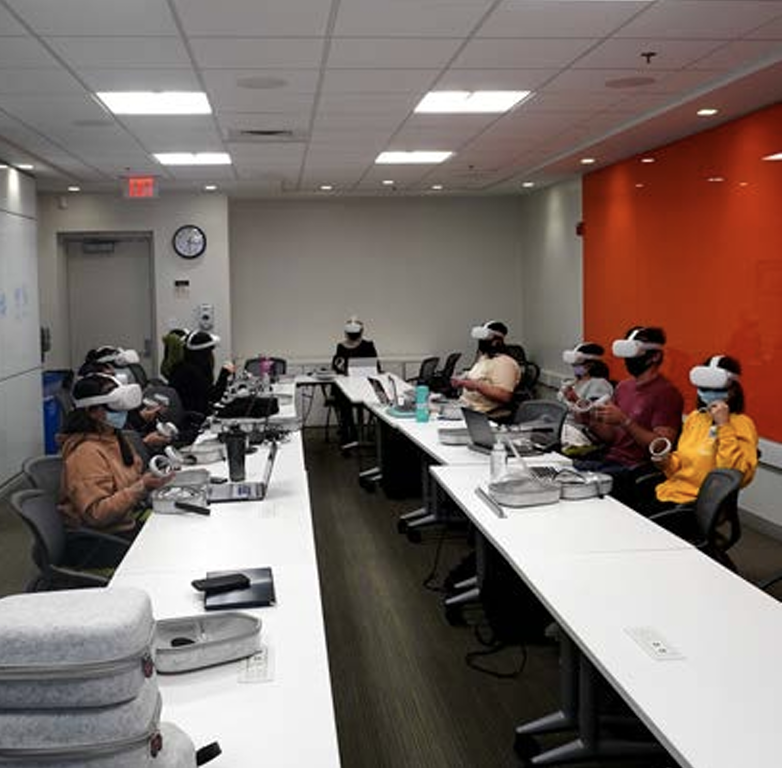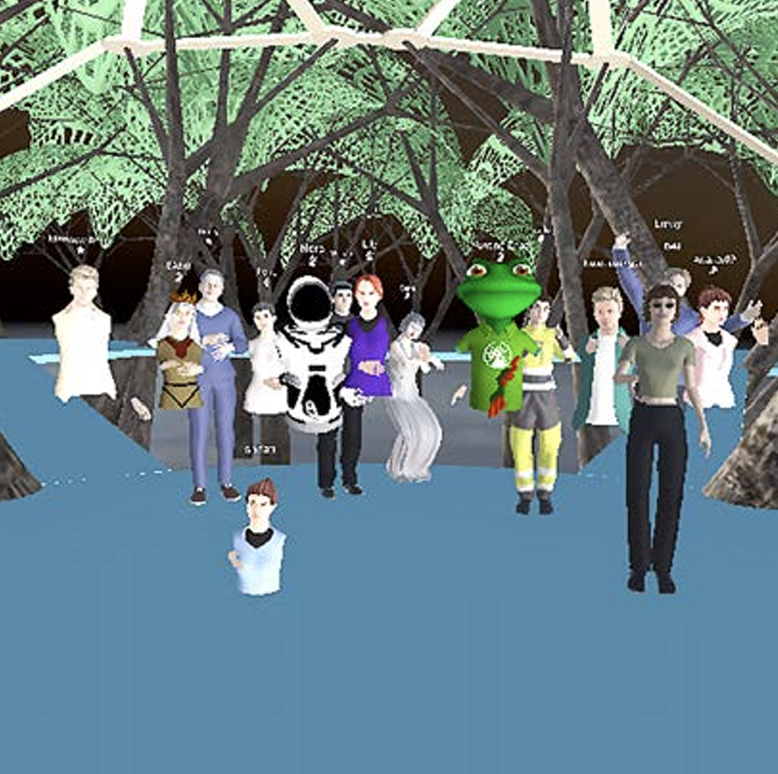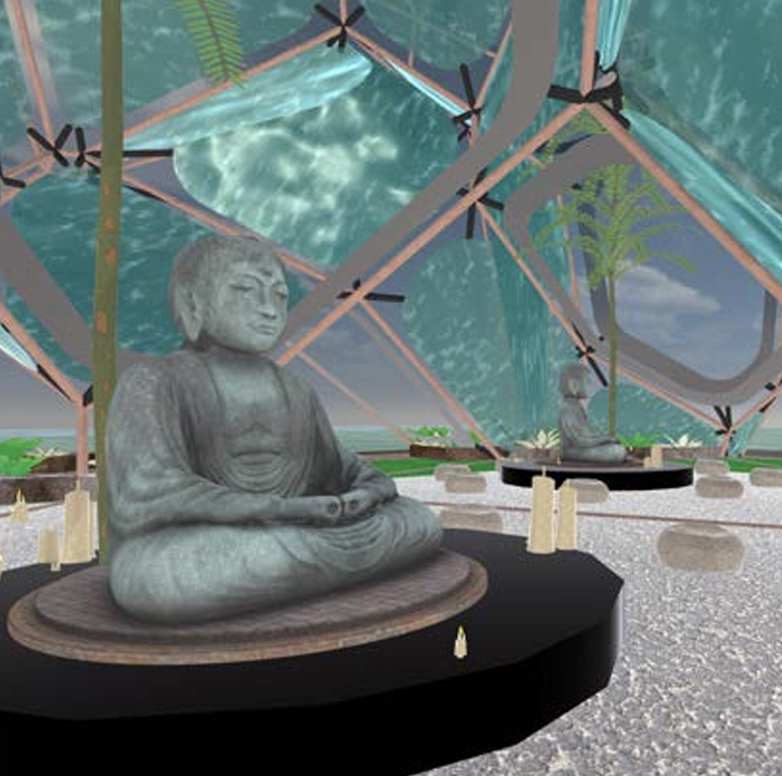| William Green Dept of Religious Studies University of Miami | Kim Grinfeder School of Communications University of Miami | Denis Hector School of Architecture University of Miami |
Sacred space is foundational in human culture. It creates an embodied experience that incorporates the range of perceptual phenomena. The immersive environment of the Metaverse enhances conventional two-dimensional, monaural audio-visual representations in education.
Religion & Sacred Space in the Era of Artificial Intelligence and Virtual Reality uses the second to understand the first. Jointly developed by Religious Studies, Interactive Media, and Architecture faculty, it is a discussion-based course conducted through VR headsets. Below we briefly review alignments of the Metaverse and Religious Studies, the operational methods of the class, and outcomes, and conclude with a reflection on aspects of the class as a foundation for discussion on future developments.
The Metaverse & Religious Studies
The Metaverse is a 3D evolution of the Internet, an environment for communication and simulation rather than computation. It allows users to explore shared experience by constructing an uncommon ground to reimagine, reshape, construct, and inhabit fabricated reality. Architect and Software Developer Andreea Ion CojoCaru describes this as “the space of human imagination, now buildable, shareable, and strangely persistent.”1 Matthew Ball, CEO of Epyllion and the former global head of strategy for Amazon Studios, defines the Metaverse as:
– A massively scaled and interoperable network of real-time rendered 3D virtual worlds that can be experienced synchronously and persistently by an effectively unlimited number of users with an individual sense of presence and with continuity of data, such as identity, history, entitlements, objects, communications, and payments”2.
The course tests the premise that as students create and occupy alternative, non-ordinary realities, the Metaverse can generate shared experiences and nurture community, providing a new platform for experiential learning. As Morie observes “Virtual environments, however, are not imaginal; they are real in the sense of the lived world.”3 Virtual reconstructions such as Duke University’s ancient Memphis project which combines telemetric and textual sources offer new opportunities for research.4
Religion & Sacred Space in the Era of AI and VR explores influences of digital culture on religion and its impact on society. It examines the role of religion in the formation of human communities through the development of prosocial values and practices and as a generator of culturally meaningful and enduring places. By inhabiting virtual sacred spaces, faculty and students study religious practices and rituals and the potential of AI and VR to shape the religious experience.
Operational Methods
Initially the class met in-person to distribute VR headsets and environment accounts, subsequently conducting all classes in the Metaverse. The first assignment was to create a personified browser or avatar as their digital self, which also references Hinduism and the Sanskrit avatar that translates as “descent,” signifying the material appearance or incarnation of a powerful deity, goddess, or spirit on Earth. The 15 students represented the three areas of study, and ranged from no to some previous VR experience.
In post-course evaluations, students commented on the sense of freedom and protection the avatars provided. In a typical response, one student noted that “the VR classrooms added a different layer of intimacy to our learning environment, where it is much easier to speak through being in an avatar.”

Fig.1, First Class meeting, (Grinfeder)

Fig.2, VR Classroom meeting,(Grinfeder)
An interesting and important quality of the avatar is its sense of physical presence- the capacity to transmit through the headset the haptic experience of the meta-spaces of the course: peripheral spatial perception, and stereo audio-location. If one moves the avatar too quickly, dizziness can occur. In preparing for rituals, we learned how to move avatars in unison and noted a physical sensation when two avatars touched hands or transmitted an item to one another. The avatar’s haptic element distinguishes the user’s experience in the Metaverse from observing on a screen.
The students formed transdisciplinary teams to help normalize coursework experience in the Metaverse. We then focused on creating a learning environment for the class meetings. Two years of remote, hybrid, and masked-in-person learning experiences during the COVID era demonstrated the critical function of shared physical space and atmosphere in learning environments; the design prompt simultaneously focused on ideal learning spaces and social spaces post-COVID isolation. Since building materials are free; the laws of physics are suspended; and the boundary conditions for design are limited only by imagination and technical competency with the applications, the students explored a range of possibilities. Although the architecture students had access to a full library of architectural tools, each group ultimately generated a nature-based space to serve as the collective, conversational learning space, with sunlight, water, greenery, atmospheric sounds, and simultaneous full access to internet technology.
The next level of work engaged the teams in creating sacred spaces and designing their corresponding, collective religious rituals. Many students claimed no religious background or experience with ritual actions. Through the collective viewing room’s 360° virtual environments, we explored sacred spaces, including the Parthenon and Sagrada Familia, and religious rituals, including a Haitian Vodou ceremony and Brazilian Ayahuasca ceremony, close enough to feel in person. The immediacy of the encounter was simultaneously sensorially immersive and removed—one of full participation and detached observation. This enabled an understanding of both ritual and sacred space substantially richer and deeper than what could be achieved through static images, traditional films, and text.

Fig.3, Meditation Refuge (Hector)

Fig.4, Immersive Water Ritual (Hector)
Outcomes
Based on this work, the students developed spaces and rites. One team created a bipartite refuge on an island setting with a smiling and slowly rotating statue of Buddha at each of the centers, around which were zafu cushions on which avatars could sit and meditate. The entire sanctuary was shaded by a system of overlapping fronds, creating a variegated light and shade pattern. When each participant had completed their contemplation, their avatar exited through a mirrored portal that framed their closing statements of self-affirmation and aims for their futures.
A second team designed and constructed a stone labyrinth through which our avatars navigated a path upward to a place for statements of religious affirmation and then ascension to an ethereal environment in which sky and heaven merged as sacred space. A third group developed an immersive water ritual in which each avatar walked down a tunnel that shimmered with cool- spectrum indirect light. Though the water level at the entry was ankle deep, the chamber floor gradually sloped downward so that participants reached complete submersion. From that point, each avatar ascended a stairway to emerge refreshed and renewed, standing on a platform floating in a dawn-lit lagoon.
All students and faculty avatars participated in each of the team-designed rituals. Because the manipulation of the avatars creates a haptic sense of peripheral vision, motion and movement, all participants had distinct corporeal experiences in the ritual actions. The distinctive nature of experiential learning in the Metaverse created an environment of “doing” rather than listening and observing.
Reflection
After classes ended, students and faculty reflected on the experience and takeaways for learning in the future. The group noted that despite the awkwardness of the devices, the Metaverse provided a portal to a learning experience that engaged the whole person. Students and faculty felt they had shared an adventure together, and students indicated that the experience drew them more deeply into more conventional exploration of the coursework as well.
A s students integrated their unique perspectives and skills to advance learning and creative exploration, their experience demonstrated the value of looking past current perceptions of technology to explore what it might offer to enhance both the character and content of classroom instruction. The exhilaration of the teams as we plunged into the worlds they had created inspires us to go further to explore how we can bring this level of excitement and accomplishments to more areas of study.
1 A podcast episode titled “Defining Process-Relational Architecture with Andreea Ion CojoCaru: Spatial Design as a Participatory Improv Performance” by Voices of VR.
2 Matthew Ball, “Forward to the Metaverse: A Primer,” MatthewBall.vc, accessed April 29, 2023, https://www.matthewball.vc/all/forwardtothemetaverseprimer.
3 Jacquelyn Ford Morie, “Ontological Implications of Being in Immersive Virtual Environments,” The Engineering Reality of Virtual Reality 2008, 6804 (2008): 680408, https://doi.org/10.1117/12.778617
4 Nevio Danelon and David J. Zielinski, “Mythological Landscapes and Real Places: Using Virtual Reality to Investigate the Perception of Sacred Space in the Ancient City of Memphis,” in Ancient Egypt, New Technology: The Application of Advanced Systems to Archaeological Enquiries, edited by Gianluca Miniaci and Stephen Quirke (Leiden: Brill, 2023), 67-88.



